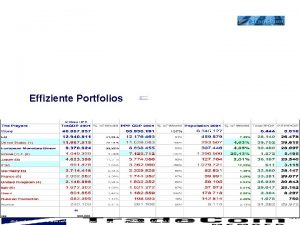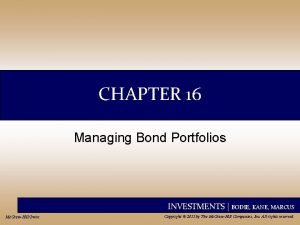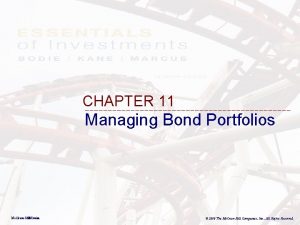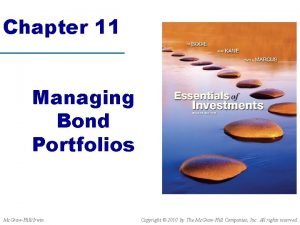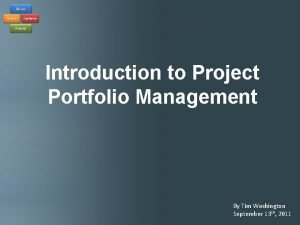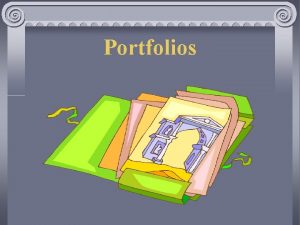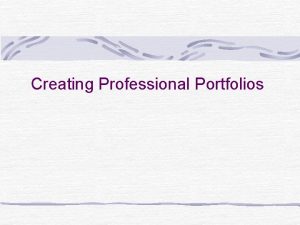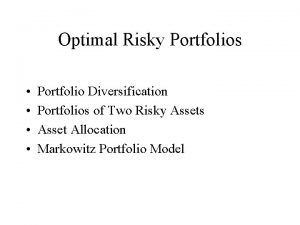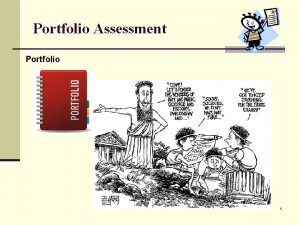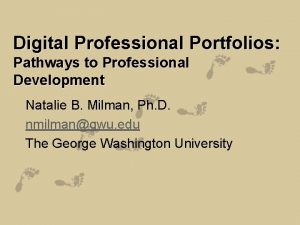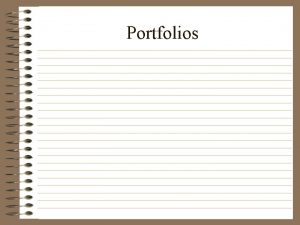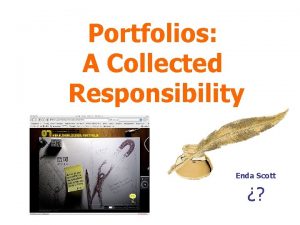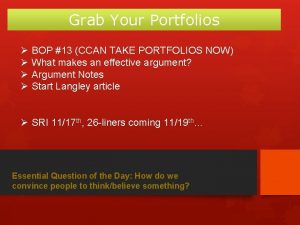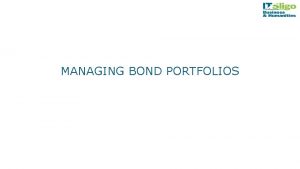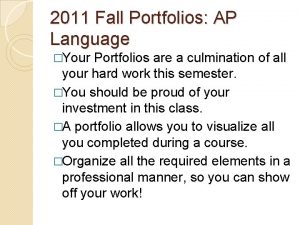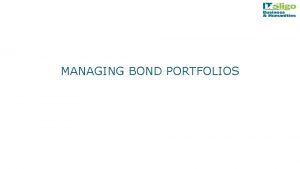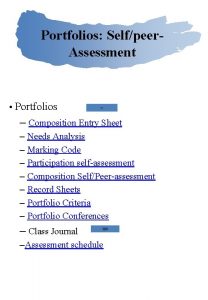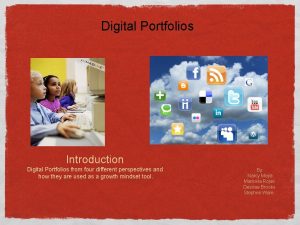Professional Portfolios Portfolios The Portfolio collection reflects a




















- Slides: 20

Professional Portfolios

Portfolios The Portfolio collection reflects a student’s interest and achievements The collection must include student involvement in selecting the content, the criteria for selection, the criteria for judging merit, and evidence of student selfreflection

Student portfolios will include Cover sheet – identifying the student Table of contents – listing of entries Letter of introduction – introduces the student Application – documentation of learned skills

Student portfolios Resume – student qualifications Academic skills – an entry from areas showcasing work and knowledge with a reflection sheet

Student portfolios 2 Letters of recommendation – show others view the student Special interests and awards – achievements in and outside of school (while being in HS)

Maintaining the portfolio Appearance – neat and clean Update – insert best work Evaluate – reflect on work collected in portfolio Replacement – insert new work displaying a greater skill mastery

Benefits of the portfolio process Tangible proof of their knowledge and skills Students develop a sense of pride and ownership from collecting their best work

Benefits Intangible self-assessment and self –esteem A portfolio provides future employers, scholarship committees or admission committees additional evaluation tools.

I. The cover letter and résumé often are the first impression that a prospective employer will have of the applicant. They must be: A. Visually appealing – typewritten on quality paper B. Free of mistakes – spelling, punctuation, factual

II. Application forms A. Guidelines 1. Print or type all items very neatly. 2. Use black ink. 3. All blanks must be completed.

B. Completing an application 1. Read the instructions carefully. 2. Answer the questions truthfully. 3. Provide only positive information.

III. Cover letter A. Appearance 1. Street Address, City, Zip. Code at top left. 2. Place date at top left under address. 3. Use professional language.

B. Salutation 1. Letter is addressed to an appropriate individual (if in doubt: Attention: Hiring Committee). 2. Begins with appropriate prefix (i. e. : Mr. , Mrs. Ms. , Dr. ).

C. Opening paragraph 1. Begins with an original opening line. 2. Incorporates specific information on how the position fits student’s career goals. 3. Identifies desired position. 4. Catches readers attention.

D. Body 1. Consists of one to three paragraphs. 2. Highlights applicants most marketable attributes. 3. Highlights qualifications and experiences as related to employer needs. 4. Examples are used to demonstrate qualifications for the position.

E. Closing Paragraph 1. Begins with a summary statement like: “Hire me – I would be good for the job because…” 2. Indicates that the candidate is assertively seeking an interview; also indicates interview availability.

3. Includes the student’s contact information (phone number and email address). 4. Email address needs to be professional. 5. Cover letter is closed with “Sincerely”; student’s typed name is included below with signature.

IV. Résumé format can vary but must contain a written summary of information in a concise, logical order. A. A résumé should include: 1. Personal identification 2. Employment objective / career goal 3. Educational background 4. Skills 5. Work experience 6. Personal references

B. Types of resumes 1. Functional résumé—focuses on what you know and what you can do rather than on your work history. Great for people just entering the job market. 2. Chronological résumé—documents your work history with the most recent job listed first.

` 3. Combined résumé—lists job skills first followed by employment history. Allows you to highlight skills needed for the type of job you are seeking.
 Effiziente portfolios
Effiziente portfolios Managing bond portfolios
Managing bond portfolios Managing bond portfolios
Managing bond portfolios Thinking algebraically stock market game answer key
Thinking algebraically stock market game answer key Pure yield pickup swap
Pure yield pickup swap Landsat collection 1 vs collection 2
Landsat collection 1 vs collection 2 Types of documentary collection
Types of documentary collection Type of portfolio
Type of portfolio Tim washington portfolio mgmt
Tim washington portfolio mgmt Thiếu nhi thế giới liên hoan
Thiếu nhi thế giới liên hoan Sự nuôi và dạy con của hươu
Sự nuôi và dạy con của hươu điện thế nghỉ
điện thế nghỉ Một số thể thơ truyền thống
Một số thể thơ truyền thống Thế nào là sự mỏi cơ
Thế nào là sự mỏi cơ Trời xanh đây là của chúng ta thể thơ
Trời xanh đây là của chúng ta thể thơ Số.nguyên tố
Số.nguyên tố Tỉ lệ cơ thể trẻ em
Tỉ lệ cơ thể trẻ em Tia chieu sa te
Tia chieu sa te Các châu lục và đại dương trên thế giới
Các châu lục và đại dương trên thế giới Thế nào là hệ số cao nhất
Thế nào là hệ số cao nhất Hệ hô hấp
Hệ hô hấp
